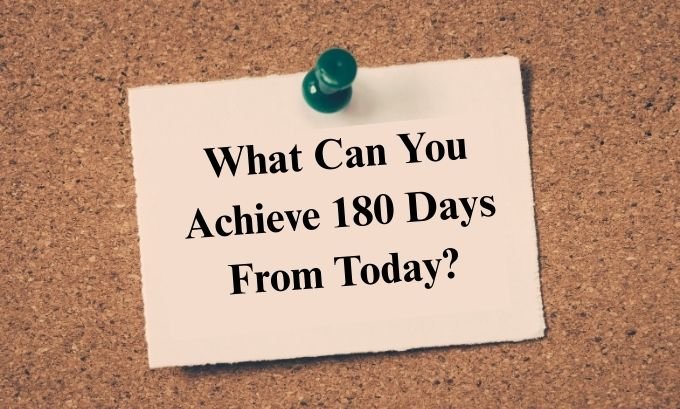If you had 180 days to achieve something remarkable, what would you choose? The next six months can be a tipping point for accomplishing your goals, whether it’s mastering a new skill, hitting a fitness milestone, or finally launching that long-awaited project. But how can you maximize these 180 days and bring your plans to life?
This guide dives into actionable strategies for setting meaningful goals, staying focused, and making the most of these 180 days from today. By the end of this blog, you’ll know how to break down ambitious plans, stay motivated, and see tangible progress.
Table of Contents
Why 180 Days Is a Game-Changer
Six months might not sound like much, but it’s the perfect timeframe to achieve significant goals without feeling overwhelmed. It offers enough flexibility to work around life’s interruptions while being concise enough to maintain focus. This timeline is frequently used by companies for setting quarterly and semi-annual objectives, and now you can apply it to personal growth.
Why it works:
- Real but realistic: 180 days gives you a fixed deadline, but it’s not so long that you’ll procrastinate.
- Sustainable change: Unlike quick-fix programs, half a year allows you to implement gradual, long-lasting habits.
- Measurable cycles: The six-month mark lets you evaluate your progress, pivot if necessary, and achieve smaller milestones.
How to Start the Next 180 Days Right
Step 1: Define Your Vision
Start with clarity. Ask yourself:
- What is the overarching goal I want to achieve?
- Why does it matter to me?
Your goal will guide your six-month period, so make sure it’s both specific and meaningful. For example:
- Instead of saying, “I want to read more,” say, “I will finish 12 books in the next 6 months.”
- Instead of, “I want to lose weight,” say, “I will lose 10 pounds through healthy eating and exercise.”
Pro Tip: Write this goal down! Studies suggest that written goals are 42% more likely to be achieved.
Step 2: Break Your Goal into Milestones
No matter how ambitious your goal, breaking it down into 30-day milestones makes it manageable. Over the next 180 days, you’ll hit six key checkpoints, allowing you to review your progress and celebrate small wins.
Example Plan for Writing a Book in 180 Days:
| Month | Milestone |
|---|---|
| 1 | Outline chapters and create a schedule |
| 2 | Write the first three chapters |
| 3 | Write the next three chapters |
| 4 | Complete the first draft |
| 5 | Revise and edit |
| 6 | Finalize the manuscript and share for feedback |

Step 3: Create Daily and Weekly Systems
Once you understand your milestones, translate them into daily or weekly habits. Systems are the backbone of success—they ensure progress even on busy or unmotivated days.
Examples of Systems Based on Common Goals:
- Weight Loss: Track calories daily and exercise 4 times a week
- Learning a New Skill: Watch 3–5 tutorial videos weekly, with 2 practice hours afterward
- Saving Money: Set a daily spending limit and automate weekly savings into a separate account
Step 4: Address Obstacles in Advance
Be proactive about what might derail you. Is it self-doubt, time constraints, or lack of resources? Identifying challenges early will make you more resilient.
For example:
- Don’t have time to work out every day? Opt for short, intense sessions like 20-minute HIIT workouts.
- Struggle with procrastination? Use time-blocking apps like Notion or focus timers like Forest to stay on task.
Step 5: Stay Accountable
Share your goals with someone you trust—a friend, partner, or coach. Research proves that accountability increases your success rate. If possible, check in with this person every 30 days to review your milestones.
You can also use online communities or tools. Apps like Habitica gamify your progress, making goal achievement fun and interactive.
FAQs About Goal-Setting Over the Next 180 Days
Q1. What kinds of goals are best suited for a 180-day plan?
A 180-day timeline works for goals that require sustained effort but aren’t so large that they’ll demand years of focus. Examples include learning a skill like coding, achieving fitness milestones, or launching a small side project.
Q2. How do I stay motivated over six months?
Staying motivated requires a mix of internal and external rewards. Celebrate small wins with meaningful rewards. For example, after completing three months of consistent progress, treat yourself to something you’ve been eyeing—it could be a new gadget, book, or meal at your favorite restaurant.
Q3. What happens if I fall behind schedule?
Falling behind is normal! The key is to reassess your plan without giving up entirely. If you missed milestone #2, adjust milestone #3 to compensate without cramming everything last minute.
Q4. Can I pursue more than one goal within 180 days?
Absolutely! Just be sure to balance your ambitions. Overloading on simultaneous goals can leave you feeling stretched thin. Consider combining complementary goals, like training for a marathon while also improving your diet.
Q5. What’s the best way to track my progress?
Regular journaling or using apps like Trello, Google Sheets, or Notion is an effective way to track your progress. Include notes about what went well and what you can improve every 30 days.
Turn Short-Term Goals into Lifelong Habits
What you achieve six months from now depends on what you choose to start today. Remember, results don’t come from sprinting to the finish line—they’re the sum of consistent, small efforts over time.
Take the first step by creating a 180-day roadmap tailored to your goal. Want to hone your time management skills along the way? Bookmark this post and revisit it every 30 days to keep yourself aligned and motivated.
Here’s to making the next 180 days count.
Looking for tools to build daily habits that support your six-month goal? Check out the curated self-improvement kits at Tokyo Mart.

